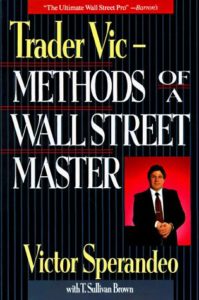I first came across Trader Vic over a decade ago while meandering through an old book store. My dog-eared and excessively highlighted copy still sits on the bookshelf next to my desk. It’s one of the few trading books I regularly turn to for a reread. The book covers everything from trade management to market psychology, to technicals and fundamentals, and even some economics.
Below are a few of my notes from the book.
On Thinking in Essentials
“If I had to reduce all the components of my methods to a single phrase, it would be thinking in essentials.
It’s not necessarily how much you know, but the truth and quality of what you know that counts. Every week in Barron’s there are dozens of pages of fine print summarizing the week’s activities in stocks, bonds, commodities, options, and so forth. There is so much information that to process all of it, and make sense out of it, is a task beyond any genius’s mental capacity.
One way to narrow down the data is to specialize in one or two areas. Another way is to use computers to do a lot of the sorting out for you. But no matter how you reduce the data, the key to processing information is the ability to abstract the essential information from the bounty of data produced each day.
To do this, you have to relate the information to principles — to fundamental concepts that define the nature fo the financial markets. A principle is a broad generalization that describes an unlimited number of specific events and correlates vast amounts of data. It is with principles that you can take complex market data and make it relatively simple and manageable.”
This is why we at MO practice Ruthless Reductionism. Einstein said, “Everything should be made as simple as possible, but not simpler”. Your information intake is a key part of your process. Strip away the fat, know what you consume and why you consume it, search for key principles and let them guide your way.
A Business Philosophy for Consistent Success
“I base my business philosophy on three principles, listed here in order of importance: preservation of capital, consistent profitability, and the pursuit of superior returns. These principals are basic in the sense that they underlie and guide all of my market decisions. Each principle carries a different weight in my speculative strategy, and they evolve from one to the other. That is, preservation of capital leads to consistent profits, which makes pursuit of superior returns possible.”
Preservation of Capital
“Preservation of capital is the cornerstone of my business philosophy. This means that, in considering any potential market involvement, risk is my prime concern. Before asking, “What personal profit can I realize?”, I first ask, “What potential loss can I suffer?”
… In my terms, money isn’t green… it’s either black or white. Black and white have come to be associated with false or true, wrong or right, bad or good. In ethical terms, most of society has been taught that ‘there are no blacks and whites — there is only gray’: gray — the mixed and contradictory — the lack of absolutes. But on a ledger sheet, htere are nothing but absolutes: 2+2 is always 4, and 2-6 is always -4! Yet, in a subtle way, the modern investor has been taught to accept gray by the money management community. He is encouraged to rejoice if his account goes down only 10% when the averages are down 20% — after all, he has outperformed the averages by 10%! This is B.S., plain and simple.
There is one, and only one, valid question for an investor to ask: “Have I made money?” The best insurance that the answer will always be “Yes!” is to consistently speculate or invest only when the odds are decidedly in your favor, which means keeping risk at a minimum.”
Consistent Profitability
Obviously, the markets aren’t always at or near tops or bottoms. Generally speaking, a good speculator or investor should be able to capture between 60 and 80% of the long-term price trend (whether up or down) between bull market tops and bear market bottoms in any market. This is the period when the focus should be on making consistent profits with low risk.
Consistent profitability is a corollary of the preservation of capital. Now what do I mean by a corollary? A corollary is an idea or a principle. IN this case, consistent profitability is a corollary of the preservation of capital because capital isn’t a static quantity — it is either gained or lost. To gain capital, you have to be consistently profitable; but to be consistently profitable, you have to preserve gains and minimize losses. Therefore, you must constantly balance the risks and rewards of each decision, scaling your risk according to accumulated profits or losses, thereby increasing the odds of consistent success.
…Anyone who enters the financial markets expecting to be right on most of their trades is in for a rude awakening. If you think about it, it’s a lot like hitting a baseball — the best players only get hits 30 to 40% of the time. But a good player knows that the hits usually help a lot more than the strikeouts hurt. The reward is greater than the risk.
Pursuit of Superior Returns
As profits accrue, I apply the same reasoning but take the process a step further to the pursuit of superior returns. If, and only if, a level of profits exists to justify aggressive risk, then I will take on a higher risk to produce greater percentage returns on capital. This does not mean that I change my risk/reward criteria; it means that I increase the size of my positions.
Trading is a business and should be treated as such. Know your edge, play the game of making money versus trying to be right, and don’t take unwarranted risks.









